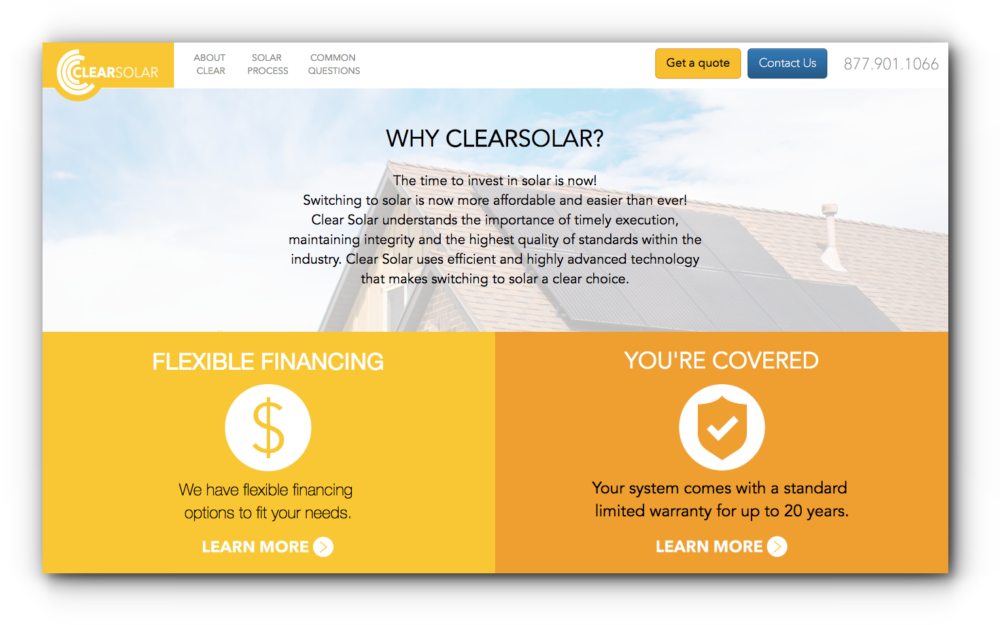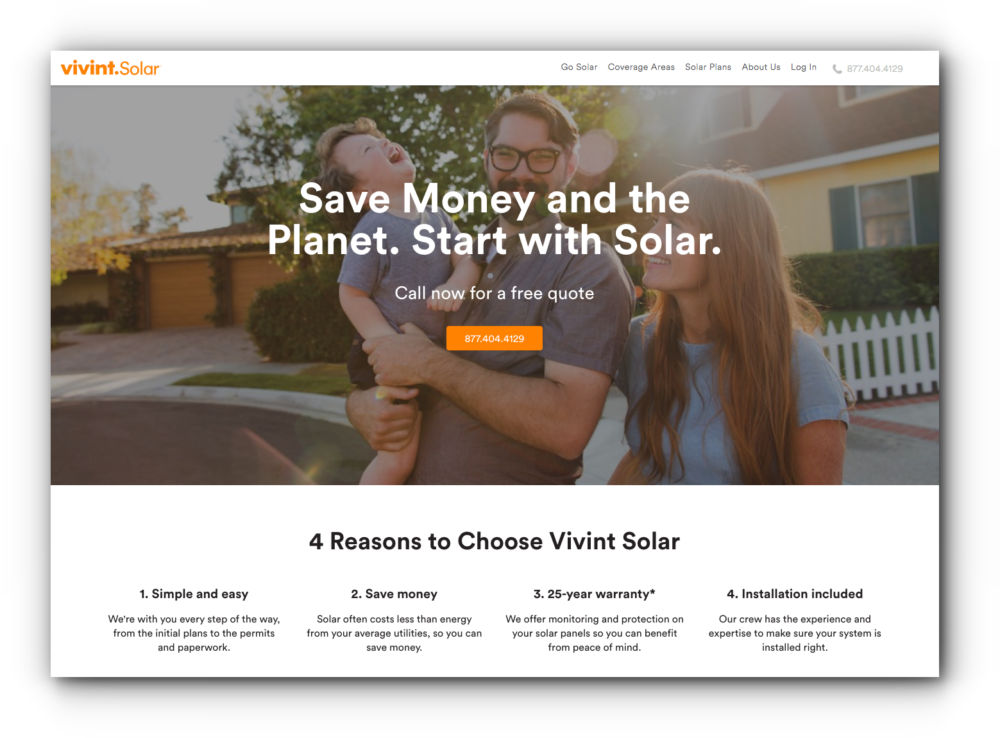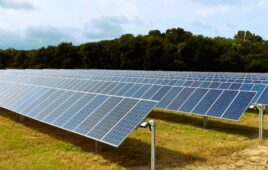A solar installer’s website is the backbone of a digital marketing strategy and the final destination for many other solar marketing efforts. It allows solar contractors to connect with residential and business prospects at all stages of the buying process by answering questions and highlighting the advantages of doing business with their particular company. But only if it’s done right.
A strong site has specific marketing goals, is targeted for clearly articulated buyer personas (representations of the company’s target solar customers) and tells visitors what they need to do and learn. By contrast, a sloppy, poorly executed website can undermine efforts to connect with customers.
For most homeowners and businesses, a solar installation is a significant investment. Establishing a high level of trust from the start is a must. This means that perusing an installation company’s site must be as seamless as possible, involving everything from fast load time, mobile responsiveness and modern design to valuable, relevant information and enticing calls-to-action (CTAs).
In today’s article, we discuss the various elements that go into making a solar installation website a powerful tool in a company’s solar marketing arsenal.
Set the tone with design
Overall, installers should aim to make the look and feel of their solar website to be as impressive as possible. Use the highest-quality images possible (not just generic stock photos or low-res images of installations) along with a modern design and layout, and keep in mind the following guidelines to make the entire website engaging.
Easy navigation
Navigation menus in the header and footer should be clearly labeled and grouped. Avoid confusing names (i.e. don’t call “About Us” something like “Backgrounder” or “Profile”) and make good use of submenus to avoid clutter or confusion. Finally, don’t bury vital items like contact info or blog in tiny font in the footer.
Readable and scan-able text
A long page of unbroken text is death to readers. They want to be able to scan a page in a few seconds and get the gist of it before they dive in with easy-to-read headings, subheadings and bullets. Collapse text or create links to shorten the amount of text to be read in a section. Throw in images and interesting quotes to break up the text and point out key info. Use white space, coloring and font size to keep text prominent and uncluttered.
Compelling content
All the snappy design in the world can’t make up for content that truly connects to a company’s prospects. Use language that speaks most effectively to specific buyer personas. For homeowners and businesses alike, a conversational, one-to-one style of writing tends to land well. The language should be concise and customer focused—use “you” instead of “we” as much as possible.
Headings and subheadings should inform the reader about solar and highlight the strengths of a specific company’s services (it’s the difference between “Your rooftop solar system” and SunPower’s “A complete system, designed to work together”). Avoid jargon-heavy or confusing technical language in the text.

Clear Solar’s website does a good job of communicating what differentiates the company in language that addresses buyer concerns.
An inviting homepage
A company’s homepage must clearly communicate its mission, what it does and what customers can do when they arrive on the website. The text should resonate with the company’s main buyer personas, be they upscale homeowners, urban dwellers, auto dealers or educational institutions. Use easily accessible CTAs for prospects at all stages of the buyer journey, such as links to explore financing or installation types more thoroughly or a button to schedule a consultation. Strong social proof like key testimonials or short video success stories can quickly establish trust.
Case studies that close deals
Success stories validate a company and build serious credibility with homeowners and businesses alike. They can range from a well-produced video to a three-page story complete with images, key customer and installer quotes and quick stats. Offering the option to download case studies is good for the commercial buyer who wants to pass them around the office. Include studies from each sector the company works in, and use benefit-driven titles like “Protecting Your Roof When Installing Solar” and “Solar Brings Down Operating Cost for Auto Dealer, Increases Profitability.”
If possible, get quotes and images from the actual customers and present these projects as stories involving the feelings of the customers, the solutions explored and the challenges overcome. All this makes much more of an impact than some photos of the installation and a dry series of bullets.

SunPower makes it easy for prospective commercial customers to find case studies that are relevant to them.
Targeted commercial information
For installers that work in commercial solar, having a dedicated section on their websites with all the information business and government prospects need to make their decisions is very effective. If applicable, have clearly delineated information for each industry served with compelling benefit-driven headings and specifically targeted content that addresses the needs and concerns of the buyers for that industry.
It can also be helpful to link to business case studies, FAQs, related blog articles and key product offerings. Cap it all off with a compelling CTA like an offer for a consultation for the business buyer ready to talk or a download of a special report on financing and commercial installs for the prospect who wants to do more research. And if commercial installs make up a significant portion of an installer’s business, they may want to consider having a dedicated search engine optimized business blog as well.
“About Us” sections that build trust
An installer’s “About Us” or “Contact” pages are important opportunities for building trust and allowing easy access to the company. Once again, the language here should be free of industry jargon and business clichés. Include actual photos of the company’s team members, whether individual management team photos or photos of the entire team in front of the company headquarters. Sharing names and faces is a great way to show the people behind the company—the kinds of folks who’ll be walking around a prospect’s backyard and climbing up on the roof.
Give a prospect multiple ways to contact the company— local contact info, a form, a phone number, an email, etc. Always make social media buttons prominent throughout the site.

Semper Solaris, a veteran-owned solar company that employs many veterans, has an “About Us” page that highlights the company’s values and origin story.
Educational content that drives traffic
Solar content marketing, the use of educational and industry-related material to attract leads to a site, can be a powerful addition to a company’s marketing efforts. Valuable, relevant reading in the form of a blog, e-book, infographic, or white paper can go a long way toward establishing a company as an authority in the industry.
This content allows companies to use keywords and links to raise its ranking in search engine results (search engine optimization, or SEO). Placing prime material behind a sign-up form is a great way to capture lead contact information. Content marketing and SEO will be discussed in more detail in upcoming posts in this series.
There are many elements that go into making a solar website an effective hub for digital solar marketing campaigns. Incorporating even a few of these strategies into an installer’s website can help increase website traffic and customers.
About Aurora’s digital solar marketing series
This article is part of an ongoing series from Aurora Solar design and sales software, providing a guide for solar companies to develop a cohesive digital solar marketing strategy to connect with more customers. We explain the value offered by different digital marketing options and highlight concrete strategies to make the most of each.
- How to use retargeting to increase solar sales conversions
- How to use Google Ads to drive traffic to your solar website
- How to harness Instagram’s visual appeal for solar marketing
- How solar contractors can make the most of Twitter
- Optimize your solar company’s presence on LinkedIn
- Effective Facebook marketing for solar contractors
- Search engine optimization (SEO) for solar contractors: Best practices
- Search Engine Optimization (SEO) for solar contractors: Choosing the right keywords
- Make your solar website the foundation for effective digital solar marketing
- Five ways digital solar marketing can grow your business







Hello Sara – Are there sources that you would recommend for furthering our knowledge even more? Thanks for all you do.,
Hi Alison – Glad you found the article helpful, and thank you for the feedback! I certainly do think that the more there is info specifically for solar contractors looking to market effectively online, the better. Best to you – Sara
This is a fantastic article! It’s got some great tips for web optimization, and I’ve never seen one catered specifically towards those in the solar industry. It’s great for those who are both building and optimizing their solar company’s website. Thanks for putting this together!